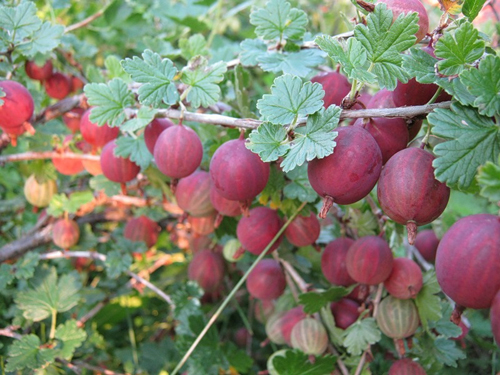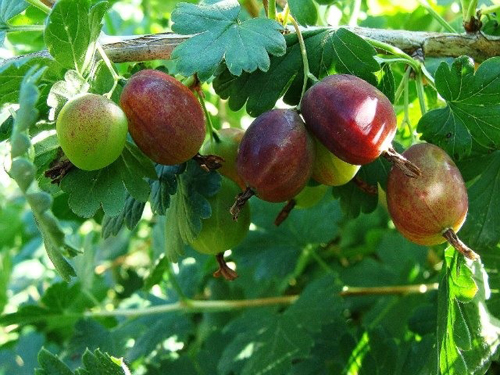Gooseberry variety Kolobok
A large-fruited gooseberry devoid of thorns is the dream of any gardener. The long and painstaking work of breeders led exactly to this result - varieties began to appear in the gardens of the Russians, devoid of or almost devoid of sharp thorns. Kolobok stands out among the list of popular varieties. It was created at the All-Russian Institute of Selection and Technology for Horticulture and Nursery, crossing the Pink-2 and Smena species. Author - I.V. Popov. The registration application was filed in 1976. After lengthy variety trials, in 1988, the novelty was registered in the state register of breeding achievements of Russia. Regions of admission - Central, Volgo-Vyatka, Central Black Earth and East Siberian. Kolobok is considered one of the best varieties for the Moscow region.

Description
The plant shows good vigor, reaching a height of 1.5 meters. The gooseberry has a strong branching and oblique direction of the branches, resulting in a dense, medium spreading bush. Young, numerous and non-lignified shoots are very long, curved, of moderate thickness, with slight branching, thornless. The bark is greenish, no pubescence. Lignified shoots are thin or medium, with light gray bark. The shrub is practically devoid of thorns. Thorns are most often found in the nodes that are located at the bottom of the branches. The thorns are short, light, dull, weak, single. In relation to the shoot, the thorn is attached perpendicularly. The buds of the variety are large, brown, conical, placed opposite the shoot, growing deviating from the shoot. The apical kidney is group. The bulk of Kolobok fruit is formed on one- and two-year branches. In inflorescence from 1 to 3 flowers. In one cluster, flowers can be large or medium. Sepals are light green, with pink edges, located freely.

The leaves of the gooseberry are green, large and smaller, concave along the central vein, with a slightly shiny surface, soft. They are located horizontally in relation to the shoot. The edge of the leaf is decorated with small teeth with rounded-blunt tops. The main veins are completely colored. The leaf plate of the variety is three-bladed. The blade located in the middle has a three-toothed apex, rounded lateral edges. The length of the middle and lateral lobes of the Kolobok is the same. The lateral lobes are short, wide, round, and obtuse. The tops are directed upwards. The basal lobes are underdeveloped. The angle of convergence of the veins of the lateral lobes is obtuse. The petiole is rounded. The petiole is short, thick, smooth, green in color, attached to the shoot at an angle of 30 °.

Gooseberry fruits are quite large - from 4 to 8 grams (however, small berries, up to 3 grams, are also found), have a rounded shape, which explains the name, colored in a dark red, sometimes cherry color. The cup is closed. The skin is of moderate density, the waxy coating is significant. The venation is medium, the veins are lighter than the main color. The peduncle is of regular length, the separation from the berry is easy. The taste of the variety is pleasant, sweet and sour, the assessment of tasters is 4.5 points. The seeds are not very large, each fruit contains 25 of them. 100 grams of raw product contains: soluble solids - 12.4%, total sugars - 8.7%, ascorbic acid - 25.0 mg, anthocyanins - 25.0 mg.
Characteristics
- Gooseberries ripen in medium terms, the fruiting period is long - from June to August;
- Kolobok's yield is good - according to the State Register, one bush gave about 4 - 6 kg of berries. According to other sources, this figure is higher and amounts to 10 kg;

- despite the easy separation from the stalk, the berries are firmly held on the branches;
- the immunity of the variety is quite high, it is resistant to powdery mildew and anthracnose;
- average winter hardiness. The plant easily tolerates cold temperatures down to -24 ° C, but suffers from alternating thaws and frosts;
- if, in a harsh and snowless winter, the plant is still frozen, recovery will take place quickly;
- drought resistance of the variety is not very high;
- Gingerbread man belongs to long-livers - lives for about 25 years;
- it is easy to breed gooseberries, the rooting rate of cuttings reaches 90%;
- the harvested crop is transported over long distances without loss of marketability;
- the purpose of using berries is universal. The fruits are consumed in their natural form as a dessert, they are used to prepare jam, marmalade, confiture.
Planting and leaving
Plants can be planted in spring, in March, or in autumn, in late October - early November. A place should be chosen well lit, gooseberries cannot stand shading. A site with a high occurrence of subsoil waters must be abandoned, the roots suffer from waterlogging. The grooming is no different from the usual. Kolobok responds to feeding with an excellent harvest. If there is no precipitation in the summer, the frequency of watering is increased. Thinning pruning is a prerequisite for the formation of a large berry. In addition, the elimination of excessive thickening reduces the risk of developing fungal diseases and the spread of pests. The planting pattern is 1 or 1.5 meters between bushes, do not skimp on the aisles, leave a width of about 2 meters.
Gingerbread man is an unpretentious and early-growing variety, its harvest lasts for a long time on the branches, which is very much appreciated by summer residents who visit their sites only on weekends. And the yield of gooseberries, with proper care, is quite normal. Another big plus is the absence of sharp thorns, so harvesting can even be entrusted to children. Of course, there are also disadvantages. Chief among them is the need for regular pruning. And, of course, you do not need to make the plant suffer from thirst during the dry season.









I don’t know what I did wrong, but my acquaintance with this variety was crowned with a complete fiasco. I was very happy when my husband brought a small gooseberry bush without thorns. Well prepared the planting pit, chose a sunny place for planting, watered with a long absence of precipitation. The bush has grown to a height of about 1.3 meters and a radius of about a meter. At 4 or 5 years old, it finally bloomed, the fruits set, but when they ripened all fell off. They didn't even try it. The next year, history repeated itself. I was very upset and dug it out completely. No more studless gooseberries!